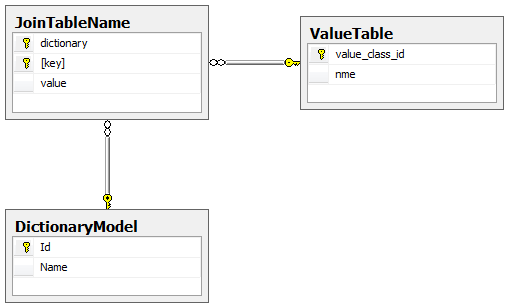Primitive Key and Reference Type Value
This topic demonstrates how to map a dictionary property with primitive key and reference type value. The key here is that you don't need to use any of the extension methods for dictionary configuration. Instead, you have to create a new many-to-many association between the class that contains the dictionary property and the class that represents the dictionary value.
Below is a sample FluentMetadataSource implementation showing you how to configure the DictionaryModel class. The class has a dictionary property with a primitive key and value that is a reference type.
public class FluentModelMetadataSource : FluentMetadataSource
{
protected override IList<MappingConfiguration> PrepareMapping()
{
IList<MappingConfiguration> preparedConfigurations = new List<MappingConfiguration>();
MappingConfiguration<ValueClass> valueClassConfig = new MappingConfiguration<ValueClass>();
valueClassConfig.MapType().ToTable( "ValueTable" );
valueClassConfig.HasProperty( x => x.ValueClassId ).IsIdentity( KeyGenerator.Autoinc );
preparedConfigurations.Add( valueClassConfig );
MappingConfiguration<DictionaryModel> dictionaryConfiguration =
new MappingConfiguration<DictionaryModel>();
dictionaryConfiguration.HasProperty( d => d.Id ).ToColumn( "Id" );
dictionaryConfiguration.HasProperty( d => d.Name ).ToColumn( "Name" );
dictionaryConfiguration.MapType().ToTable( "DictionaryModel" );
dictionaryConfiguration.HasProperty( d => d.Id ).IsIdentity( KeyGenerator.Autoinc );
dictionaryConfiguration.HasAssociation( x => x.IntValueDictionary ).
MapJoinTable( "JoinTableName", ( x, y, z ) => new
{
dictionary = x.Id, // The DictionaryModel.Id property
key = y,
value = z.ValueClassId
} );
preparedConfigurations.Add( dictionaryConfiguration );
return preparedConfigurations;
}
}
Public Class FluentModelMetadataSource
Inherits FluentMetadataSource
Protected Overrides Function PrepareMapping() As IList(Of MappingConfiguration)
Dim preparedConfigurations As IList(Of MappingConfiguration) = _
New List(Of MappingConfiguration)()
Dim valueClassConfig As New MappingConfiguration(Of ValueClass)()
valueClassConfig.MapType().ToTable("ValueTable")
valueClassConfig.FieldNamingRules.AddPrefix = "_"
valueClassConfig.HasProperty(Function(x) x.ValueClassId).IsIdentity(KeyGenerator.Autoinc)
preparedConfigurations.Add(valueClassConfig)
Dim dictionaryConfiguration As New MappingConfiguration(Of DictionaryModel)()
dictionaryConfiguration.HasProperty(Function(d) d.Id).ToColumn("Id")
dictionaryConfiguration.HasProperty(Function(d) d.Name).ToColumn("Name")
dictionaryConfiguration.FieldNamingRules.AddPrefix = "_"
dictionaryConfiguration.MapType().ToTable("DictionaryModel")
dictionaryConfiguration.HasProperty(Function(d) d.Id).IsIdentity(KeyGenerator.Autoinc)
dictionaryConfiguration.HasAssociation(Of Integer, ValueClass)(Function(x) x.IntValueDictionary).
MapJoinTable("JoinTableName", Function(x, y, z) New With {Key .dictionary = x.Id,
Key .key = y,
Key .value = z.ValueClassId})
preparedConfigurations.Add(dictionaryConfiguration)
Return preparedConfigurations
End Function
End Class
The resulting database schema should look like the snapshot below:

DictionaryModel Class
public class DictionaryModel
{
public DictionaryModel()
{
this.IntValueDictionary = new Dictionary<int, ValueClass>();
}
public int Id {get;set;}
public string Name {get;set;}
public IDictionary<int, ValueClass> IntValueDictionary {get;set;}
}
Public Class DictionaryModel
Public Sub New()
Me.IntValueDictionary = New Dictionary(Of Integer, ValueClass)()
End Sub
Private _id As Integer
Public Property Id() As Integer
Get
Return _id
End Get
Set(ByVal value As Integer)
_id = value
End Set
End Property
Private _name As String
Public Property Name() As String
Get
Return _name
End Get
Set(ByVal value As String)
_name = value
End Set
End Property
Private _intValueDictionary As IDictionary(Of Integer, ValueClass)
Public Property IntValueDictionary() As IDictionary(Of Integer, ValueClass)
Get
Return _intValueDictionary
End Get
Set(ByVal value As IDictionary(Of Integer, ValueClass))
_intValueDictionary = value
End Set
End Property
End Class
ValueClass
public class ValueClass
{
public int ValueClassId {get;set;}
public string Name {get;set;}
}
Public Class ValueClass
Private _valueClassId As Integer
Public Property ValueClassId() As Integer
Get
Return _valueClassId
End Get
Set(ByVal value As Integer)
_valueClassId = value
End Set
End Property
Private _name As String
Public Property Name() As String
Get
Return _name
End Get
Set(ByVal value As String)
_name = value
End Set
End Property
End Class
